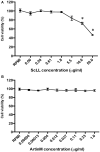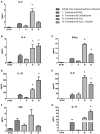Lectins from Synadenium carinatum (ScLL) and Artocarpus heterophyllus (ArtinM) Are Able to Induce Beneficial Immunomodulatory Effects in a Murine Model for Treatment of Toxoplasma gondii Infection
- PMID: 27933277
- PMCID: PMC5122570
- DOI: 10.3389/fcimb.2016.00164
Lectins from Synadenium carinatum (ScLL) and Artocarpus heterophyllus (ArtinM) Are Able to Induce Beneficial Immunomodulatory Effects in a Murine Model for Treatment of Toxoplasma gondii Infection
Abstract
Infection by Toxoplasma gondii affects around one-third of world population and the treatment for patients presenting toxoplasmosis clinically manifested disease is mainly based by a combination of sulfadiazine, pyrimethamine, and folinic acid. However, this therapeutic protocol is significantly toxic, causing relevant dose-related bone marrow damage. Thus, it is necessary to improve new approaches to investigate the usefulness of more effective and non-toxic agents for treatment of patients with toxoplasmosis. It has been described that lectins from plants can control parasite infections, when used as immunological adjuvants in vaccination procedures. This type of lectins, such as ArtinM and ScLL is able to induce immunostimulatory activities, including efficient immune response against parasites. The present study aimed to evaluate the potential immunostimulatory effect of ScLL and ArtinM for treatment of T. gondii infection during acute phase, considering that there is no study in the literature accomplishing this issue. For this purpose, bone marrow-derived macrophages (BMDMs) were treated with different concentrations from each lectin to determine the maximum concentration without or with lowest cytotoxic effect. After, it was also measured the cytokine levels produced by these cells when stimulated by the selected concentrations of lectins. We found that ScLL showed high capacity to induce of pro-inflammatory cytokine production, while ArtinM was able to induce especially an anti-inflammatory cytokines production. Furthermore, both lectins were able to increase NO levels. Next, we evaluated the treatment effect of ScLL and ArtinM in C57BL/6 mice infected by ME49 strain from T. gondii. The animals were infected and treated with ScLL, ArtinM, ArtinM plus ScLL, or sulfadiazine, and the following parameters analyzed: Cytokines production, brain parasite burden and survival rates. Our results demonstrated that the ScLL or ScLL plus ArtinM treatment induced production of pro-inflammatory and anti-inflammatory cytokines, showing differential but complementary profiles. Moreover, when compared with non-treated mice, the parasite burden was significantly lower and survival rates higher in mice treated with ScLL or ScLL plus ArtinM, similarly with sulfadiazine treatment. In conclusion, the results demonstrated the suitable potential immunotherapeutic effect of ScLL and ArtinM lectins to control acute toxoplasmosis in this experimental murine model.
Keywords: ArtinM; ScLL; Toxoplasma gondii; lectins; therapeutic agents.
Figures






Similar articles
-
ArtinM, a D-mannose-binding lectin from Artocarpus integrifolia, plays a potent adjuvant and immunostimulatory role in immunization against Neospora caninum.Vaccine. 2011 Nov 15;29(49):9183-93. doi: 10.1016/j.vaccine.2011.09.136. Epub 2011 Oct 12. Vaccine. 2011. PMID: 22001880
-
Adjuvant and immunostimulatory effects of a D-galactose-binding lectin from Synadenium carinatum latex (ScLL) in the mouse model of vaccination against neosporosis.Vet Res. 2012 Oct 29;43(1):76. doi: 10.1186/1297-9716-43-76. Vet Res. 2012. PMID: 23107170 Free PMC article.
-
Recombinant TgHSP70 Immunization Protects against Toxoplasma gondii Brain Cyst Formation by Enhancing Inducible Nitric Oxide Expression.Front Cell Infect Microbiol. 2017 Apr 25;7:142. doi: 10.3389/fcimb.2017.00142. eCollection 2017. Front Cell Infect Microbiol. 2017. PMID: 28487847 Free PMC article.
-
[Toxoplasma gondii: a potential role in the genesis of psychiatric disorders].Encephale. 2013 Feb;39(1):38-43. doi: 10.1016/j.encep.2012.06.014. Epub 2012 Aug 21. Encephale. 2013. PMID: 23095600 Review. French.
-
The immunomodulatory effect of plant lectins: a review with emphasis on ArtinM properties.Glycoconj J. 2013 Oct;30(7):641-57. doi: 10.1007/s10719-012-9464-4. Epub 2013 Jan 9. Glycoconj J. 2013. PMID: 23299509 Free PMC article. Review.
Cited by
-
Promising Plant-Derived Adjuvants in the Development of Coccidial Vaccines.Front Vet Sci. 2019 Feb 12;6:20. doi: 10.3389/fvets.2019.00020. eCollection 2019. Front Vet Sci. 2019. PMID: 30809529 Free PMC article. Review.
-
The lectin ArtinM activates RBL-2H3 mast cells without inducing degranulation.PLoS One. 2020 Mar 24;15(3):e0230633. doi: 10.1371/journal.pone.0230633. eCollection 2020. PLoS One. 2020. PMID: 32208440 Free PMC article.
-
Targeting the Immune System with Plant Lectins to Combat Microbial Infections.Front Pharmacol. 2017 Oct 4;8:671. doi: 10.3389/fphar.2017.00671. eCollection 2017. Front Pharmacol. 2017. PMID: 29046636 Free PMC article. Review.
-
Lectins as Promising Therapeutics for the Prevention and Treatment of HIV and Other Potential Coinfections.Biomed Res Int. 2018 May 8;2018:3750646. doi: 10.1155/2018/3750646. eCollection 2018. Biomed Res Int. 2018. PMID: 29854749 Free PMC article. Review.
-
Ovicidal and toxicological effect of hydroalcoholic extracts of Euphorbia milli var splendens, Synadenium carinatum Boiss and Tagetes minuta L. against Ancylostoma spp.: In vitro study.J Parasit Dis. 2021 Mar;45(1):252-257. doi: 10.1007/s12639-020-01302-9. Epub 2020 Nov 7. J Parasit Dis. 2021. PMID: 33746411 Free PMC article.
References
-
- Alegre-Maller A. C., Mendonça F. C., da Silva T. A., Oliveira A. F., Freitas M. S., Hanna E. S., et al. . (2014). Therapeutic administration of recombinant Paracoccin confers protection against Paracoccidioides brasiliensis infection: involvement of TLRs. PLoS Negl. Trop. Dis. 8:e3317. 10.1371/journal.pntd.0003317 - DOI - PMC - PubMed
Publication types
MeSH terms
Substances
LinkOut - more resources
Full Text Sources
Other Literature Sources
Medical

